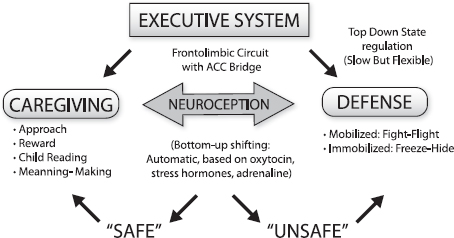

Sarah, mother of 12-month-old Vincent, is watching videos of her son while having her brain imaged. She is watching two different scenes. In one video, Vincent is laughing gleefully as Sarah blows big wet bubbles at him. In the other, Vincent is crying because Sarah has just left the room. As Sarah watches the happy Vincent scene, parts of her left hemisphere light up on the imaging screen—parts of the brain known to be connected to what brain scientists call the reward system. Although we cannot see it on the screen, chemicals, including oxytocin and dopamine, are flooding these regions of Sarah’s brain. In contrast, as Sarah watches the scene of Vincent in distress, parts of her brain on the right side become very active—brain regions associated with responding empathically to a loved one’s pain. Now, different chemicals, including one much like adrenaline, are spurting into regions of Sarah’s brain that ramp up her vigilance and make her intensely and somewhat painfully aware of Vincent’s distress. We are watching the healthy parenting brain in action.
Creating stable structures lasting over many years for the protection and rearing of children is essential, as our offspring, compared to those of other mammals, are the weakest and require the longest care.
—Donatella Marrazziti (2009, p. 265)
Like Vincent, our precious children depend completely on us, as parents, and perhaps more specifically, on the healthy functioning of our brains to parent well. Children’s brains thrive when interacting with adults who have the brain capacity to love them unconditionally, experience joy from being with them, pay close attention to them, and understand them deeply. In short, nothing is more important to parent–child relationships and to children’s development than the health of parents’ brains.
We have to be moved by our interactions with our children if we are going to be responsive to their needs and stay connected to them. It’s not enough just to notice that your child is upset; you have to feel something in response to seeing and hearing your child’s distress. We take this process of being moved as parents for granted, but in this book, we are going to take a close look at what neuroscientists have learned about how we are able to feel these essential parental feelings, how our brains and bodies talk to each other in ways that enable us to be parental, to be caring and sensitive with our kids.
Although the process of becoming a parent may seem a “no brainer,” the process of parenting taps all of the brain power we can muster. Parental love and sensitive, responsive parenting are made possible by a core brain system that emerged in the transition from reptiles to mammals, a process that involved essential changes in the structure and chemistry of the brain. Mammals acquired new brain structures, such as the cingulate, the insula, and the orbital cortex, and brain chemicals such as oxytocin, vasopressin, and prolactin, that made it possible to develop a lovely obsession with taking care of babies—a parental preoccupation with offspring that can be seen in mammals great and small, from mice to whales and elephants. Sea turtles, meanwhile, lacking these structures and chemicals, invest all of their parental energy in laying and protecting eggs. They then return to the sea, leaving their offspring to their fate.
At its core, parenting is an emotional process emanating from deep within our brains, from a set of tightly connected regions, called the limbic system, which is in constant communication with our bodies, especially with our hearts, lungs, and gut. Literally, parenting rests on connections between the brain and the body that enable us to generate loving feelings and to be intensely motivated to care for our children. While we use higher, more uniquely human parts of our brains in our parenting, we rely heavily on the same core system of parental care that evolved millions of years ago to make parental love possible (Fleming & Li, 2002).
The parent–child relationship can foster feelings of deep love and empathy, but it can also trigger self-defensive feelings and give rise to impulses that are “unparental.” Loving feelings and trust are rooted in safety, in the kind of “felt safety” that is more primal and instinctive than the knowledge that you should feel safe. In order to sustain an empathic style of parenting, you have to have a visceral sense of safety as you interact closely with your child, both in times of quiet joy and in times of conflict. Love is a state of openness to another person, and it competes in our brains and bodies with closed states of self-defense. Parenting well requires the ability to stay open and engaged with our children most of the time, not closed off to them as we defend ourselves against feeling unsafe or insecure.
In neuroscience terms, parenting rests upon a process of regulating our internal “states of mind,” a so-called state regulation system that is under development in early childhood (Porges, 2011). Parenting relies upon our social engagement system, a brain–body state that enables us to get very close to other people without getting defensive. Our state regulation system orchestrates internal shifts in our approach behavior (typically open and non-defensive) and our avoidance (defensive) behavior. Our brains mediate these shifts by using automatic, unconscious, bottom-up processes and by using more conscious, “top-down,” and effortful processes. Becoming aware of this bottom-up and top-down state regulation process helps us to understand ourselves as parents and how we manage to stay parental in spite of the stresses and strains we inevitably experience along the way.
In particular, parenting rests upon the development of strong connections between our brains and our hearts. This brain–heart connection is based on a branch of a complicated, wandering nerve called the vagus nerve. The whole vagal system travels from our digestive tract all the way up to the brainstem, connecting all regions along the way to our brains. This system is the basis for that part of our nervous system called the parasympathetic system. In contrast to the sympathetic nervous system that ramps us up, increasing our heart rate when we need to be mobilized for action, such as in the defensive modes of fight and flight, the parasympathetic system is active when we are in relatively immobile states, relaxing, digesting, watching a movie, and so on. The bottom parts of the vagal system connect the gut to the brain and orchestrate basic relaxation, digestive processes, and the freeze/immobilization mechanism that we can use as a defense if we encounter an inescapable, life-threatening threat. The upper vagal system connecting the heart and lungs to the brain is a more recently evolved system that only exists in mammals. This is the system that supports social interaction and makes it possible, neurologically, to connect deeply with other people rather than become defensive and attack or run from them. It is this upper vagal system that is essential to good parenting.
Stephen Porges (2011), a neuroscientist who has devoted his career to understanding how humans are able to be such social creatures, calls this upper vagal system the “smart vagus” because it allows us to regulate our heart rate and our breathing very flexibly across a wide range of feelings without shifting fully into a defensive reaction. This is the system that enables a parent to stay grounded and emotionally “present” when the parent–child relationship becomes stressful or strained. The smart vagal system supports social engagement, connection, and mutual understanding by helping parents to stay in tune with a child’s experience and to keep their lids on even while their usually loving son is blowing his top.
The smart vagus not only effectively connects the lower regions of the prefrontal cortex to the heart and lungs; it also controls the muscles of the upper parts of the face that we use to express positive emotions. This smart vagal system (which Porges also calls the ventral vagal system) also orchestrates voice quality or “prosody,” the musical quality of the voice, as exemplified in “motherese,” the way parents typically vocalize to their babies in higher-pitched, sing-song tones. Furthermore, Porges explains, this vagal circuit has a connection to a muscle in the inner ear that is vital to the process of tuning our hearing to the frequencies used in human speech. This connection allows us to be good listeners and to attune to both the content of speech and to the prosody, the subtle musical qualities of each other’s voices.
When this smart vagal system is “on,” in parents and children, both are able to feel safe enough to communicate openly. In this shared state of sociability, parents and children can sustain a deep level of engagement without shifting into defensive states incompatible with the uniquely human form of communication that Trevarthen calls “intersubjectivity” (Trevarthen, 2001; Trevarthen and Aitken, 2001). Intersubjective communication is the sharing of inner experiences-thoughts, feelings, dreams, misgivings- between parent and child, as opposed to more superficial kinds of behavioral interactions that are often necessary, but do not promote deeper understanding of each other and a deepening of emotional connections. Open-minded parenting, resting heavily on the smart vagal system, promotes intersubjective communication, the kind of parent-child communication that helps children feel deeply understood and valued by their parents. The smart vagal system helps parents to stay in this open-minded internal state much of the time, regulating competition between this openness and defensive reactions that are usually false alarms and don’t really require self-defense. When parents have a well-developed social engagement system, they can stay open and receptive to a child’s full range of emotions and to their own internal feelings without defaulting to a self-protective, self-centered state of mind. In a sense, good vagal tone—that is, a well-developed smart vagal system—provides the brain support for a parent’s tolerance of the stresses and strains of parent–child interactions. Parents with good vagal tone have larger windows of stress tolerance and a greater capacity to regulate strong emotions than parents with poor vagal tone. Figure 1.1 illustrates the smart vagal system.
Figure 1.1 The Smart Vagus Connecting the Brain and the Heart
This is the circuit that supports social engagement and parental openness.
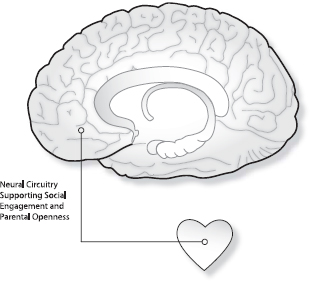
The goal, then, is to stay in the open state of social engagement as much as possible, as illustrated in Figure 1.2. This is quite challenging for all parents because the process of interacting with children is inherently stressful and, inevitably, at times, triggers defensive feelings that are not consistent with the caring feelings we want to have. The social engagement system is only activated when we feel safe enough being near another person.
Next, we consider how our brains determine whether we are safe enough to stay focused on parenting rather than shifting our focus to our own physical or psychological well-being.
Figure 1.2 Using the Smart Vagal System to Support Flexible, Open Parenting.
Vagal tone in parenting terms translates into engagement, flexibility, and stress tolerance.
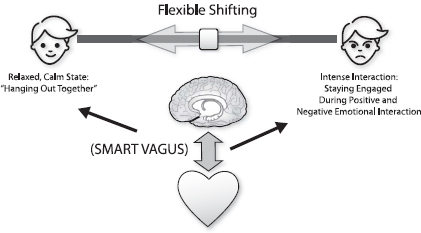
To effectively switch from defensive to social engagement strategies, the mammalian nervous system needs to perform two important adaptive tasks: (1) assess risk, and (2) if the environment is perceived as safe, inhibit the more primitive limbic structures that control fight, flight, or freeze behaviors.
—Porges (2011, p. 57)
Our brains rapidly assess our social environment for safety or danger using an automatic screening process that works under the radar of our conscious awareness. Porges calls this the neuroception system to distinguish it from the more conscious process of perception. This neuroception system is orchestrated by a brain region called the amygdala (shown in Figure 1.3), the brain filter for all incoming sensory information as well as for all information coming into the brain from the body. The amygdala is part of what neuroscientists call the “limbic system,” a group of structures in the mammalian brain that generate emotions and orchestrate the basic processes of approaching and avoiding things in life. As a key part of the limbic system, the amygdala receives input from all of the external senses and from the body and is able to detect a potential threat in less than 1/10 of a second, much faster than the time it takes for our brains to create a conscious thought or feeling (Davis & Whalen, 2001). If the amygdala detects a threat, it can instantly switch our brain circuits from approach to defensive avoidance. If the threat level is moderate, not life-threatening, we are likely to activate our sympathetic nervous system, taking us into our fight or flight system, at least enough to raise our heart rate and increase our level of vigilance. If the threat is sensed as life-threatening or overwhelming and inescapable, the amygdala triggers our parasympathetic system, the lower vagal system that promotes immobilization, a shutdown response that, in effect, prepares us for a relatively pain-free death. This is the same system that animals use to “play dead” when they are about to be eaten by a predator and that we use to dissociate and to stop caring about what is happening.
If the neuroception system does not detect any real threat, it activates our social approach system, engendering a sense of safety and promoting trust between people. When this system is “on”—when, in effect, the amygdala has been tamed—other brain systems that mediate self-defensive reactions are “off.” When we are able to activate this basic “approach” system as a parent, the rest of the parenting process, including the ability to experience intense pleasure from being with our children, turns on and fosters the development of enduring emotional bonds with our kids. Most of the time, these connections are robust enough to trump competing emotions inevitably triggered by interacting day after day with our children for the many years it takes for humans to reach maturity.
Figure 1.3 Location of the Amygdala
The amygdala has both input and output regions so that it can receive all kinds of sensory inputs, including the five basic senses, and from the visceral regions, including the heart and the gut. It then can use this input to either suppress or activate output pathways to the rest of the brain and to the body.
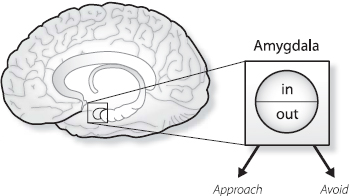
Although the amygdala reacts to both positive and negative stimuli, it appears to specialize in threat detection, fear conditioning, and harm avoidance, especially on the right side of the brain. It appears that the amygdala on the left side is more involved in generating conscious feelings and emotions related to approaching rather than avoiding things in life (Whalen & Phelps, 2009).
Since everything that we sense, both externally and internally, runs through the amygdala for a quick appraisal of its survival value, the amygdala plays a key role in the parental brain in quickly and roughly assessing whether it is safe to be close to and fully engaged with a child or whether there is something threatening about this intimate contact. This gives the amygdala a very important role in helping parents to orchestrate the process of staying parental and in connection with their child rather than shifting into a defensive state that disconnects parents and children from each other emotionally and psychologically. All mammals have the basic circuitry for performing this neuroceptive process.
According to Porges, “the neuroception of familiar individuals and individuals with appropriately prosodic voices and warm, expressive faces translates into a social interaction promoting a sense of safety” (2011, p. 58). In humans, the amygdala is very responsive to facial expressions, especially to eye contact and eye movements. This quick reaction to eye contact, which can be positive or negative, is thought to be one of the difficulties that people with social phobia and those on the autism spectrum have with sustaining face-to-face interaction with others. The amygdala is especially sensitive to changes in the region of the face around the eyes, including the lowering or arching of the brow, changes in pupil size and brightness, and shifts in gaze. Human eyes have the greatest contrast between light and dark, apparently a feature that helps us read other people’s eyes to determine their trustworthiness. Even newborns pay more attention to a direct gaze than to averted eyes, whether it’s a real face or a drawing. Although being eye-to-eye may engender intimacy and loving feelings, it may also set off a defensive reaction in the amygdala if someone stares at us in an unfriendly way. Living in a threatening environment can sensitize the amygdala to angry and fearful facial expressions, lowering the threshold for triggering defensive reactions to other people (Pollak, 2003).
A key area of the amygdala involved in parenting is called the medial region. The medial amygdala has much to do with our approach and avoidance reactions to other people (Mayes et al., 2009). This region is involved in rapid, automatic switching between these two responses of approaching versus avoiding (van Reekum et al., 2007). One of the ways that this switching is orchestrated without the involvement of a higher control process is through the release of oxytocin into the medial amygdala by pleasant experiences with other people, including “good touch” and warm, friendly voices. The amygdala has receptors for oxytocin and when these receptors are “occupied,” this has a quieting effect on the amygdala (Veenama & Neuman, 2008, Domes, et al., 2007). In this way, oxytocin helps to inhibit the defensive, avoidant reaction system, enabling the social engagement approach system to stay on. In short, the release of oxytocin is an important automatic, bottom-up, process for helping a parent stay connected to a child rather than shifting into a self-defensive state that creates an emotional barrier between parent and child.
The amygdala is online and basically ready to work in the newborn infant’s brain. Although there may be a brief period of time after birth that the amygdala is not yet very sensitive, it appears that exposure to highly stressful stimulation can override this early buffering system and activate the amygdala prematurely. At any rate, this threat detection system is available very early in the first year of life and orchestrates much of the infant’s initial social and emotional learning, in conjunction with lower regions of the prefrontal cortex that have ties to the amygdala, especially the orbital region at the bottom of the prefrontal cortex.
BOTTOM LINE: In parenting terms, the amygdala mediates rapid assessment of safety or threat, thereby playing a key role in moving us instinctively toward, or away from, our children.
In a healthy brain, the amygdala works in conjunction with a structure adjacent to it in the temporal lobe called the hippocampus (see Figure 1.4). The hippocampus is a crucial and intriguing part of the your brain because of its multiple roles. It …
• Constructs conscious, autobiographical memories.
• Helps to put emotional reactions in context of time and place.
• Gives birth to new brain cells (neurogenesis).
• Helps to regulate the stress response system (Andersen, Morris, Amaral, Bliss, & O’Keefe, 2007).
You can appreciate the many roles of the hippocampus if you have ever known someone with dementia; the hippocampus is eventually destroyed in patients with Alzheimer’s disease.
This structure is essential for making parental memories, learning from parenting, dealing with stress, keeping the parental brain healthy, and making new brain cells.
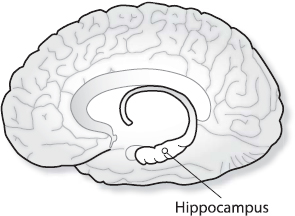
In a healthy brain, the amygdala and the hippocampus work well together to help put emotional experiences into context. However, the hippocampus is slower to mature and come online in development than is the amygdala, and it is also quite sensitive to stress hormones. The slower development of the hippocampus has much to do with why early childhood is such a purely emotional stage of social learning and development, a period of life when many experiences are immediate, intense, and only remembered implicitly—that is, indirectly, in terms of unconscious clues such as smells, sounds, sights, and proprioception—rather than explicitly—that is, in terms of conscious and specific contexts often involving time and place and events (what is termed autobiographical memory, one of several kinds of explicit memories). The hippocampus is needed to make explicit autobiographical memories, the kind we usually are referring to when we speak of memory (Siegel, 1999; Wall & Messier, 2001). To summarize:
• Implict emotional memories are nonverbal memories orchestrated by the amygdala and not involving conscious awareness. (There are other kinds of implicit memories that do not involve the amygdala, such as “procedural” memories of how to do various things in life, like riding a bike). Example of an emotional implicit memory: as an infant, Gail hears her father yelling at her mother and forms an implicit memory that associates males with feelings of fear. Then, later in life, being around men triggers extreme discomfort in Gail without her knowing what is really causing this reaction. These kinds of memories resulting from exposure to highly stressful or very pleasurable experiences very early in life are the basis of preverbal emotional conditioning that can cause strong reactions later in life to stimuli or events similar to those encountered in early childhood. These kinds of “triggered” memories seem to come from nowhere, causing feelings and bodily reactions that we don’t understand.
• Explicit memories are verbal, conscious memories requiring hippocampal processing, only possible when the hippocampus is sufficiently mature and healthy. Example: When Jimmy was 5 years old, he was stung by a bee. Many years later, he could recall this experience and describe what it felt like. He tended to be quite afraid of bees and he knew why.
• Autobiographical memories are memories of events in our lives, including who, what, where, and when, and they require both the amygdala and hippocampus to capture both the feelings and context of the experience. Example: When Rob was 8, his Dad took him to his first major league baseball game, an experience that Rob recalled vividly at age 20, remembering being in the stands, having a hotdog, and hearing his dad rooting for the home team and then being sad when they lost.
As the brain develops, the amygdala and hippocampus work together to create emotion-driven memories that are embedded in time and place, memories that neuroscientists call contextualized. These are the kind of autobiographical memories that allow us to recall where we were, when we were there, and whom we were with when emotionally significant experiences occurred. These memories eventually get stored in our long term memory, but can be retrieved and compared to the present moment to tell if there is a difference or if there is a match between the present experience and past experiences. Before the hippocampal system really starts to work effectively, probably somewhere late in the second year of life, the brain is only capable of making amygdaloid emotion-based memories or procedural memories of how to do things.
Since the hippocampus is quite sensitive to stress hormones such as cortisol and to excitatory brain chemicals such as glutamate, it is a part of your brain that can be harmed by too much stress reactivity (McEwen, 2004). Poor hippocampal functioning and even structural changes to this region are common features of many psychiatric disorders, from depression and anxiety to posttraumatic stress disorder (PTSD) and schizophrenia. Protecting the hippocampus in early development is a very important goal from the perspective of promoting healthy brain growth and resilient functioning. Since the amygdala is closely connected to, and interacts with, the hippocampus, overactivation of the amygdala can be a source of toxic effects on the functioning, growth, and structure of the hippocampus.
BOTTOM LINE: In parenting terms, the hippocampus helps us put parenting experiences in perspective, manage stress, learn from our experiences, make new brain cells, and create rich memories of being with our children.
The terms bottom up and top down refer to lower and higher brain circuits, or what brain scientists call the ventral (lower) and dorsal (higher) “streams” for processing information. (It helps to remember the difference between dorsal and ventral if you picture the dorsal fin of a shark sitting on the top of that big body.) The bottom-up stream in our brains is the one that is tightly connected to our visceral organs—our hearts, lungs, adrenal glands, and digestive tract—making this brain circuit the one that generates affect, meaning all kinds of feelings and sensations. Affects include all of our emotions, sensations, and visceral reactions to things we like and want to approach and things we dislike or fear and want to avoid. When this lower stream is activated, we feel something is happening to us. We have gut reactions and heart-felt responses that make us take things personally. This bottom-up stream, then, is the one that is really “on” when we are experiencing something from an egocentric or “me- centered” perspective. In fact, in people who have clinical paranoia (clinical means that the condition is severe enough to warrant a psychiatric diagnosis), brain imaging shows that only the bottom-up stream is on (Drevets, 2000); the upper stream is essentially out of commission, and this is why people with paranoia believe that everything they are experiencing is about them; they literally lack the brain power, at least in these moments, to distinguish between what is really “about me” and what is “not about me.”
The upper stream of the brain is not directly connected to our visceral selves. We use this “cooler” brain circuit to understand or look at something more objectively, as if from above, less passionately and less personally. So, in an important sense, we need both of these brain streams, the lower and the higher, to be able both to feel our emotions and sensations—to “resonate” in response to our experiences—and to put our experiences in perspective by distinguishing between what is really personal and what is not (Beuregard, Levesque, & Bourgouin, 2001; Ochsner, Ray, et al., 2004). Since the bottom-up stream is the one that is tied to our limbic system, it is the circuit that is vital to our immediate survival, the system that performs the neuroceptive, unconscious “first-take” screening of the information coming from our external and internal senses. This is the system that we use to appraise everything in life first for its immediate survival value and for rapidly assessing whether we are safe or in danger.
The amygdala is part of the lower stream, whereas the hippocampus functions, in part, as a bridge between the two streams. The amygdala receives from and feeds back to every sensory region of the brain, whereas the hippocampus receives information that has already been highly processed in a multi-sensory fashion by other regions of the brain and then shares this well-processed information with higher brain regions (LeDoux, 2002). Both the lower and upper streams feed their “output” into the prefrontal cortex, making that region your headquarters for integrating the two streams, for putting your emotion-based, more subjective experience together with your more objective, cooler-headed, and “cognitive” way of making sense of what is going on. Damage to the prefrontal cortex makes this integration difficult or even impossible in more severe cases. (The most famous case in neuroscience is that of Phineas Gage, who suffered damage to his prefrontal cortex that destroyed the vital connections between his ventral and dorsal systems. Search “Phineas Gage” on the Internet to read about his 19th-century experience.)
The upper stream develops more slowly and works more slowly, creating a scenario in which the lower brain circuit can dominate the upper much more easily than the upper or top-down system can modulate the lower. Even as adults, then, we can still, at times, be at the mercy of our bottom-up brain–body system, temporarily losing the moderating functioning of our top-down system. Figure 1.5 shows the two streams connecting in the prefrontal cortex. As you can see, the lower stream is the one that is directly connected to your heart and to your smart vagal system. The prefrontal cortex is the integration zone for the lower and upper streams, making it possible for you to be aware of your feelings and, at the same time, to think about what is happening in your relationship with your child, to “feel and deal.” Figure 1.5 illustrates the interaction of bottom-up (affect regulation) and top-down (reflective) processes.
BOTTOM LINE: In parenting terms, bottom-up and top-down brain processes integrate parental feelings and thinking in an adaptive, flexible way.
Developing the capacity for being a consistently nurturing parent begins in the parents’ early childhoods. Early parent–child interactions set the stage, not just metaphorically or psychologically, but neurobiologically, for the later capacity to be sensitive, caring parents. During the first year of life, the child’s brain starts to develop more connections between the lower and the upper streams of the brain. These connections are essential for the regulation of emotion and for developing the ability to connect the processes of feeling and thinking, to be able to deal with emotionally arousing events in life in a flexible, resilient way. During the first 18 months of life, the child’s amygdala grows two-way connections to higher brain regions located in the lower parts of the prefrontal cortex (National Scientific Council on the Developing Child, 2008; Schore, 1994). The two parts of the prefrontal area that are most important in forming these frontolimbic connections are the orbitofrontal cortex and the anterior cingulate cortex (for short, just anterior cingulate), as shown in Figure 1.6.
The Ventral (Lower) and Dorsal (Upper) Brain Systems Meeting in the Prefrontal Cortex, Which Integrates the Input from the Two Systems. ACC = anterior cingulate cortex; PFC = prefrontal cortex.
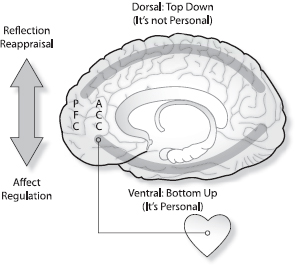
The reason that the orbitofrontal cortex and anterior cingulate are so important to child development and, ultimately, to parenting is that these two regions can directly inhibit the activity of the amygdala and help to modulate the threat-detection process (neuroception) and state regulation process discussed above. In a healthy, mature brain, the orbital region and the anterior cingulate, working in connection with the amygdala, are more in charge of your emotions and your stress reactions than your amygdala by itself. This means that you have more power to regulate the way you react to emotionally arousing things in life, including things your child does that trigger unparental feelings in you. These connections between the orbitofrontal cortex and the nearby anterior cingulate with your amygdala are core elements of your “executive” brain, the system for regulating emotional reactions and orchestrating the process of staying in control of your actions even when experiencing strong negative feelings and impulses. This makes it extremely important that a child’s brain grows good connections between the orbitofrontal cortex, the anterior cingulate, and the amygdala to form an effective executive brain system for self-regulation—a process that goes on very actively during the first 18 months of life and then continues as we mature.
Figure 1.6. The Frontolimbic System.
The orbitofrontal cortex (OFC) and the lower anterior cingulate cortex (ACC) connect to the amygdala to form a brain circuit for self-regulation.
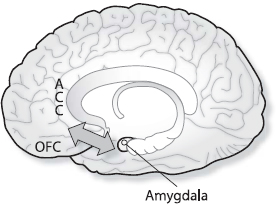
Neuroscience has revealed the process by which good parent–child and poor parent–child relationships are passed on, generation to generation. It is now quite well established by this body of research, which spans different species of mammals, that early care influences the development of offsprings’ brains in enduring ways—ways that greatly impact the way adults are likely to parent the next generation (National Scientific Council, 2010). This intriguing body of research, called maternal or parental effects, is revealing, down to the level of specific gene activity, how the early environment impinges upon the brain (Francis, Champagne & Meaney, 2000). In essence, this research shows that early experiences “tune” and “sculpt” key brain circuits involved in stress responsiveness and in social–emotional processes. This programming of a child’s developing brain adapts to this first social niche in ways that reflect the specific nature of the care the child encounters. In effect, this early “experience-dependent” process prepares the child’s brain to live in a world that is similar to the first environment in terms of the level of safety and danger this environment presents.
Just as the child’s exposure to a particular language in the first year of life tunes the language-learning circuitry to the specific sounds of that native tongue, and in doing so, makes it harder for the child’s brain to hear all of the sounds of another language later in life, exposure to a particular social and emotional niche tunes the child’s brain in ways that make the brain resistant later on to changing this basic social program for relating to other people. The developing brain is dedicated to learning a basic strategy for both staying connected to the vital lifeline that attachment figures represent and also for staying vigilant enough around these figures if they are not consistently safe to be near.
This preverbal strategy for relating to other people is called an attachment style, of which there are several, and these styles, whether secure or insecure, are rooted in early brain development reflecting the interplay of genes and environment (Siegel, 1999). Indeed, recent research using brain imaging of adults with different attachment styles shows specific brain “signatures” associated with these styles (Strathearn & Fonagy, 2009; Swain & Lorberbaum, 2008). At the most fundamental level, this is why these early attachment styles tend to be so enduring, often staying consistent from the first year of life into adulthood and affecting the style of parenting we adopt (Van IJzendorn, 1995).
The initial tuning of the social–emotional brain circuitry and stress response systems tends to endure and to keep running the same old programs even when presented with “new” information in response to the old behaviors. Nature has ensured that we will not give up original strategies for survival easily. Understanding the enduring nature of early programming of the social brain can go a long way toward helping both parents and therapists grasp why it can be so challenging to sustain the parenting process with a brain that has been tuned to living defensively rather than living in safe connections with others.
BOTTOM LINE: In parenting terms, early brain development lays the groundwork for self-regulation and personal security, helping to build a healthy parenting brain.
While early development sets the stage for being a caring person, the actual process of becoming a parent promotes hormonal changes that help to shift the brain from a primary focus on one’s own resources and competencies (i.e., the all-about-me phases of adolescence and young adulthood), which is developmentally appropriate, to an intensive focus on caregiving. While this hormonal “priming” of the brain for parenting is much more variable in fathers than in mothers of different species, becoming a dad also changes the brain in many species, at least enough to keep the fathers from harming their own infants (Veenama & Neuman, 2008). In some species, including humans, both mothers and fathers undergo powerful brain changes that shift the brains of both from other preoccupations to a keen interest in protecting and nurturing the young. In these co-parenting species, a similar process of brain changes typically promotes “pair bonding,” or the development of lifelong adult connections after mating (Carter, 2005). In species such as prairie voles and titi monkeys that show these patterns of pair bonding and co-parental care, we see the origins of the kind of family systems that most humans value. And in some species, including humans, nonbiological parents can develop a nurturing brain; just being exposed to children can activate the caregiving system.
Neuroscientists such as Sue Carter opened a gold mine for understanding the brain mechanisms of emotional bonding by uncovering the role of neuropeptides (protein-like molecules used by neurons to communicate with each other), specifically of oxytocin and vasopressin, in promoting both adult bonding and parent–child bonding in animals (Carter, 2005; Insel & Shapiro, 1992). Oxytocin and vasopressin are active in the brains of both women and men, with oxytocin playing a bigger role in women, vasopressin in men. In both moms and dads, oxytocin plays a very important part in helping to promote the bonding process between parent and child. Parents whose brains release a lot of oxytocin into the limbic regions—that is, the amygdala, the hippocampus, and the orbitofrontal cortex—tend to be very nurturing parents who experience their interactions with their children as often highly pleasurable.
Oxytocin acts much like an antianxiety medicine in your brain, helping to keep your amygdala-driven alarm system calm while activating your brain’s approach system, the smart vagal system that Porges describes as the neural basis for loving relationships. Vasopressin is more associated with persistent behavior and with aggressive “defense of the homeland,” which may be why it is more of a “player” in the neurobiology of the father than the mother. Vasopressin in the father’s brain probably helps to promote a fatherly preoccupation with the safety and well-being of his family at the same time that oxytocin helps the dad feel safe and comfortable when interacting closely with his kids (Bales & Carter, 2003). Maybe the different actions of oxytocin and vasopressin in fathers have something to do with why some dads are primarily motivated to be “bread winners,” others really enjoy nurturing and playing with their kids, and some do both really well. More research is needed (and is underway as we write) to sort all of this out more clearly.
What neuroscientists found, when they set out to learn why parent–offspring and adult–adult bonds are much stronger in some species of mammals than in others, is that the big factor is location, location, location: where in the brain the receptors for oxytocin and vasopressin are most prevalent or “dense” (Carter & Keverne, 2002). All mammalian species appear to release oxytocin during lovemaking, a chemical reaction that can temporarily deactivate the defense systems that would otherwise make the process of mating impossible. But here’s the key: In species that mate for life and form strong, enduring bonds between parents and offspring, there are lots of receptors for oxytocin in the reward center of the brain—in the nucleus accumbens region that is a critical part of our social engagement system and the parenting brain.
The nucleus accumbens is actually part of our motor system, key to what one neuroscientist calls our “seeking system” (Panksepp, 1998). When anything in life activates our nucleus accumbens by causing dopamine to flow into this region and activate receptors there, we get attached, even a bit addicted to, that thing, be it our spouse-to-be, our kids, our cars, our shoes, and, yes, drugs and alcohol. All things rewarding in life ultimately send a message to the nucleus accumbens, using dopamine as the key transmitter. So, if in your parental brain, the activities of parenting light up your nucleus accumbens through a chain effect involving both oxytocin and dopamine, then you are going to experience being a parent differently from someone whose brain does not do this, or doesn’t do it as strongly as your brain does. Furthermore, the density of receptors for both oxytocin and dopamine in a parent’s brain depends, in part, on how that parent was parented, on the quality of care he or she received early in life. Good care promotes the “expression” of the genes for oxytocin and dopamine receptors, and this means that a child’s well-cared-for brain makes more of these receptors.
This oxytocin–dopamine–nucleus accumbens scenario is also affected by your stress level. Under significant stress, even if you have a well-developed reward system, this system may be suppressed or knocked out, at least temporarily, by your stress reaction system—specifically, by stress hormones. So, when your stress system is on, your reward system is probably off; these two systems are basically in competition with each other, vying to “decide” whether you should be seeking something pleasurable or whether you need to be defending yourself. Your amygdala plays a big part in this “decision” process. People or animals with damaged amygdalas approach new things in life very readily, showing little concern about possible harm or danger. This is also true of kids with William’s syndrome; these are super-friendly children who have underactive amygdalas and overactive people-processing regions of the brain. Becoming familiar with your amygdala and the kinds of things it reacts to in life is an important part of learning to regulate your own stress and manage your tendencies to approach and avoid things in your life, including your children.
Another area of the brain that is part of the parental priming process and is responsive to oxytocin is called the medial preoptic area. The medial preoptic area is a part of the hypothalamus, a collection of nuclei near the middle of the brain concerned with all of the basic drives in life: hunger, thirst, sex, sleep, and caregiving. In research across species of mammals, from rodents to people, the medial preoptic area has been shown to be a vital region of the brain for priming maternal behavior following the birth of offspring (Numan & Stolzenberg, 2008). Its role in fathers’ brains is less clear because in males, the medial preoptic area is more strongly connected to mating behavior. In the generally more mysterious paternal brain, there appear to be interactions with other regions of the brain that help to suppress defensive reactions and enable a dad to be nurturing. At any rate, researchers have learned a lot about the parenting brain from studying how parenting is primed by certain hormones, shifting the brain into a state of readiness for a suite of caregiving processes, including building shelter, nursing, grooming, and retrieving the young when they get “lost.” It is this priming process that helps make babies so endearing and irresistible to their parents.
What brain chemicals initiate this priming of the medial preoptic area? Estrogen appears to be the key here, and prolactin, best known for stimulating milk production in nursing mothers, also plays a very important role, surprisingly, in fathers as well as mothers. When estrogen is released into the medial preoptic area, it apparently sensitizes the receptors for prolactin and for oxytocin (which is produced and released from two other regions of the hypothalamus). When oxytocin is released into the medial preoptic area, after estrogen priming of this region, the medial preoptic area gets actively involved in promoting parental activity, signaling the body to rev up milk production, and signaling other regions of the brain, especially the reward system, to become highly responsive to infant stimuli, including odors, touch, facial expressions, and vocalizations.
In short, the priming of the medial preoptic area leads to the sensitization of the emotional brain and the people-reading regions of the brain to prepare the parenting brain to be especially interested in, and attentive to, the newborn child. Working together, these brain regions get the parenting process up and running, initiating a proactive suite of caregiving behaviors and making interactions with infants pleasurable. This bottom-up, hormonally driven scenario in the parenting brain constitutes the core mammalian systems of approach and reward that we call the Parental Approach System and the Parental Reward System. These two brain systems are shared across species for helping to ensure that parents are highly motivated to take care of their babies and to find the process memorable and essentially irresistible. These processes in the brain of the parent basically shift the brain’s priorities from nonparental concerns to the tasks of parenting and help to maintain this parental state of mind for the duration of the period of time it takes to rear offspring to maturity. If this system for jump-starting and maintaining the parenting process does not work well or is suppressed for any reason, the whole parenting process suffers, creating a risk for blocked care. As we discuss more in Chapter 3, these systems can be suppressed by unmanageable levels of parental stress.
Experiments with rat moms show the power of this shift in priorities from before giving birth to after. “Virgin” female rats shun infant rats at first, either avoiding them or attacking them. “Primiparous” or first-time mothers, in sharp contrast, prefer contact with baby rats to a shot of cocaine. Their priorities then shift back over the time span in which baby rats mature up to weaning, so that by the time weaning is taking place, that cocaine is looking a lot better than it did when the kids were little (Fleming, Gonazalez, Afonso, & Lovic, 2008).
The parenting process is primed hormonally in human parents much as it is in simpler mammals. Although our parenting also involves the highest regions of our large prefrontal cortex, which give us greatly enhanced executive powers to regulate ourselves and to act in accordance with higher goals and intentions, we are still highly affected by the functioning of this mostly subcortical, bottom-up parenting system that we inherited from simpler species in the course of mammalian evolution. The role of the core parenting brain system in humans is demonstrated in many ways; for example, research shows that mothers and fathers release oxytocin during positive, pleasurable interactions with infants and that levels of prolactin rise in both mothers and fathers when both are involved in child care (Feldman, Gordon, & Zagoory-Sharon, 2010).
One of the most intriguing findings in research on the parenting brain is that interacting with offspring powerfully activates the brain’s reward system (Fleming et al., 2008). The reward system is heavily tied to the chemical dopamine, which is released into the nucleus accumbens when something pleasurable is encountered in life, including drugs of abuse. Once the dopamine system learns about a good thing, it stores a memory of it and then fires in anticipation of having that rewarding experience again. Research shows that our reward system is turned on by interacting with our children. This is an extremely important process that helps to ensure that we will stay engaged and highly motivated to care for our kids. In Chapter 3, we discuss how stress can suppress this system, making it very difficult to sustain the caregiving process. Suppression of the Parental Reward System is one of the core mechanisms of blocked care.
As we saw in the opening vignette about Sarah’s brain, brain-imaging studies literally show the activation of the parental reward system in parents’ brains when they are looking at pictures of their children or listening to recordings of their children’s voices (Swain & Lorberbaum, 2008). Recent brain-imaging studies comparing the brain reactions of parents with secure and insecure adult attachments show intriguing differences, particularly in their brain activity when listening to recordings of their children crying. Whereas the securely attached parents appeared to activate their reward pathways in response to these sounds of distress, the insecurely attached parents showed a more complicated pattern of brain activity in which they appear to be activating conflicting systems of approach and avoidance (Strathearn & Fonagy, 2009).
BOTTOM LINE: In parenting terms, priming of the parental brain prepares the parent to become preoccupied with the well-being of the newborn child and to enjoy the process of caring for the child
In addition to this vital priming process, parents need to be moved emotionally and viscerally by interacting with their children in order to stay motivated to nurture them deeply, repeatedly, and for many years. In the literature on parenting, terms that appear frequently in describing rather intangible but important qualities of parental responsiveness to children are empathy and warmth. Actually, parental empathy and warmth are related to brain processes involving pathways that connect our bodily reactions to things in life to regions of our brains that allow us to be moved by these bodily reactions. So, empathy and warmth have to do with the ability to feel one’s bodily reactions to things in life, to be aware of our gut reactions and the workings of our limbic systems. In order to experience empathy, these reactions have to register in brain regions that create the conscious experience of being moved by other people.
We focused earlier on the amygdgala as an important part of the emotional brain. A less well-known brain region, called the insula, is now receiving a lot of attention from brain scientists. The insula is now considered to be the “visceral” brain or the part of the cortex where information is received from the activity of our visceral organs, including the heart, lungs, and gut (Craig, 2009). People who are keenly aware of their bodily sensations, including the beating of their hearts, have very active insulas, especially on the right side of the brain. The activation of the insula is actually now thought to be a key part of the neurobiology of intuition, our “gut sense” about things that we cannot really explain but “just know.” Like many brain regions, the insula creates a map of the information it processes—in this case, a map of the visceral systems of the body. Parts of the insula, when activated, trigger feelings of disgust and negative social emotions such as envy and jealousy. Other parts, in contrast, trigger positive, loving feelings that promote social engagement and intimacy (Cozolino, 2006).
Whereas people who experience intense feelings and tune in easily to other people’s emotions show high levels of activity in the insula, people who report little awareness of feelings, including bodily sensations, have sluggish insulas and tend to lack intuitive knowledge about other people’s internal states. In clinical terms, people who are alexithymic—that is, who are not aware of their feelings—have underactive insulas (Gundel et al., 2004). It is easy to see how the insula plays an important role in the parenting brain and how individual differences in insula reactivity could affect parental empathy—the ability to attune on a visceral, intuitive level, to a child’s inner experiences.
Researchers make an important distinction between empathy and the more cognitive process of mentalization or what is often referred to, rather clumsily, as “theory of mind.” Empathy is the more emotion-based, visceral attunement process that occurs quite automatically, whereas mentalization is a more intentional, cerebral process that involves the ability to understand a child’s verbal and nonverbal communication. Mentalization involves higher regions of the parenting brain, including the middle region of the prefrontal cortex or the medial prefrontal cortex. Both empathy and mentalization abilities are important to parenting (Baron-Cohen, 2003).
As a key part of the parental empathy system, the insula, specifically the front or anterior region of this structure, is highly connected to another brain region that is very important to parenting, the anterior cingulate. This important insula–anterior cingulate connection is shown in Figure 1.7.
Figure 1.7. The Insula-Anterior Cingulate: Key to Parental Empathy
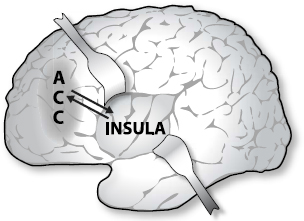
As mentioned earlier, the anterior cingulate is a structure that is basically nonexistent in the brains of reptiles. Its emergence in the transition from reptiles to mammals is thought to be strongly related to the emergence of sustained parental care in mammals, especially to the ability of a parent to respond to offsprings’ distress vocalizations (i.e., crying). Destruction of the anterior cingulate in animals or people greatly reduces parental interest in offspring, leading to a lack of responsiveness eerily reminiscent of parental neglect (Cohen et al., 2006). It is clear from this research that the anterior cingulate is an essential part of the parenting brain. Later, we describe how the anterior cingulate also functions as a vital bridge between emotion regulation and reflective processes in a parenting brain, literally connecting the core parenting process to the highest human cognitive abilities (Allman, Hakeem, Erwin, Nimchinsky, & Hof, 2001).
A unique kind of brain cell, found only in mammals that exhibit heightened awareness of each others’ emotions, especially states of distress, links the anterior insula to the anterior cingulate. These cells are called von Economo neurons after the man who discovered them. Von Economo neurons are most plentiful in humans, but are also found in a few other mammals that we know to be quite empathic: elephants, great apes, dolphins, and whales (Allman, Tetreault, Hakeem, & Park, 2011). (Although you might think, if you are a dog owner, that canines would certainly have these cells, they have not yet been found in this species.)
Intriguingly, people’s brains show differences in the size of both the anterior insula and the anterior cingulate and differences in the density of von Economo neurons. And, even more intriguingly, these differences correlate with differences in empathy, both when measured in self-report tasks and observed in actual parent–child interactions (Cohen et al., 2006). So something very important is going on in these brain regions having to do with their connections and the actual number of VEN cells that connect them. Of great relevance to parents and therapists, there is evidence that the insula and the anterior cingulate respond to experiences in life by either contracting or expanding (Cozolino, 2006). Engaging in compassion meditation, for example, has recently been shown to foster expansion in both the anterior insula and certain parts of the anterior cingulate (Posner, Rothbart, Sheese, & Tang, 2007; Tang et al., 2010). This “experience-dependent neuroplasticity”—changes in brain processes or structure in response to lived experience—is very exciting to clinicians who are following this brain research (e.g., Siegel, 2010).
BOTTOM LINE: In parenting terms, the insula–anterior cingulate–von Economo neurons system promotes parental empathy and intuition, key components of the parental attunement process.
Another fascinating and groundbreaking finding in brain research was the discovery of mirror neurons: motor cells in primates that are activated by watching another primate or human engage in some type of intentional or purposeful action, such as reaching for something to eat. Since the accidental discovery of these mimicry cells by a group of Italian neuroscientists in the 1990s (Carr, Iacoboni, Dubeau, Maziotta, & Lenzi, 2003), brain researchers have found that humans have this same mirroring system. In fact, mirror cells are more abundant in the motor systems of humans than in the primates where they were first discovered. The mirroring process is an unconscious brain mechanism that is now thought to facilitate empathy and attunement between people, including between parent and child. Mirror cells are motor neurons that are activated either by our own intentional movements or by watching each other do things. This includes watching each other make facial expressions and gestures as we interact. Our voices can also activate mirror cells.
Mirroring leads to subtle activation of the same muscles that we use when we are engaging in the type of action that we are observing. On a simple level, the contagion of yawning is probably the work of the mirroring system. When we mirror each other, we also tend to feel, at least subtly, some of what the other person is experiencing. This is why many neuroscientists think that this mirroring process contributes greatly to empathy and to interpersonal attunement, including parent–child attunement. Young children have active mirror systems as well as parents, so mirroring is a reciprocal process (Norris & Cacioppo, 2007).
The mirroring mechanism occurs much more quickly in brain time than the time it takes to understand what another person says, so this system “trumps” verbal communication in its ability to affect the subjective experience of the “mirrorer.” The mirroring process then primes our emotional responses to one another below conscious awareness and, often, in ways that are inconsistent with the content of our verbal messages. When the mirrored communication is inconsistent with the verbal messages, this inconsistency can be an important source of misattunement and misunderstanding between parents and children.
Mirroring in the parent–child relationship swings both ways: It has the potential to foster empathy and to engender mutual defensiveness, depending upon what is being mirrored. The potential for mirroring to be a disruptive influence between parent and child is heightened when a parent, without being aware of it, displays subtly negative facial expressions and tones of voice while thinking that he or she is communicating something quite different with his or her words. Or, a similar conflict can occur even in interactions with a preverbal child when the parent displays “micro” expressions, fleeting facial expressions, of fear, or anger, or disgust, which the child’s mirror system detects even though these aren’t known to the parent or consciously processed by the child (Tronick, 2007).
Parents with unresolved, stress-inducing memories from their past or parents who are experiencing current high levels of stress are likely to express the negative effects of these processes in their nonverbal communication while interacting with their children. Such a scenario can lead to the development of mutually defensive feelings between parent and child when the child mirrors the parent’s stress and then exhibits signs of his or her own distress that the parent, in turn, mirrors back (Tronick, 2007). This process can create a negative cycle that is completely unintended by parent or child. These hidden interpersonal processes can foster blocked care as well as possibly transmitting trauma silently from one generation to the next in the absence of child abuse or neglect. This is why attachment-focused therapists and trauma specialists strongly recommend that parents find ways to come to terms with their own past experiences and to defuse the negative potential for unresolved painful memories to disrupt their parenting and their kids’ development.
BOTTOM LINE: In parenting terms, mirroring strengthens the parent’s ability to attune to a child’s conscious or unconscious intentions as a part of the parent’s child-reading system.
Although we rely heavily on the bottom-up, hormonally driven processes that foster and support the core caregiving process, we also need to use all of our great cognitive resources to parent well. Our brains have to have good connections between the deeper regions that generate emotion or “affect” and the higher regions that allow us to step back enough from our more primal reactions to reflect upon our experiences with our kids and to think about them and their needs.
Left to its own workings, our subcortical limbic system has a few basic interests: seeking, finding, and consuming the “good stuff” in life; detecting and defending ourselves against the “bad stuff”; and “connecting” with others, sexually and in other ways. The limbic system is essentially devoted to moving us rapidly toward or away from things in life that are relevant to our survival. If we want our children to develop their own powers of self-regulation, we need to regulate our limbic reactions in our dealings with them.
As we have seen, the top-down, bottom-up brain arrangement that supports parenting has to grow and develop. This process that begins very early in life extends at least into our early 20s when our prefrontal cortex “matures” enough to help us orchestrate our lives more “frontally” than we could even a few years earlier. This frontal power reaches a mature level when the prefrontal cortex is strongly connected both to the back of the brain, making a robust horizontal circuit, and to the limbic system, making a robust vertical or frontolimbic circuit (Giedd, 2010). The process of strengthening these connections has much to do with myelination, the insulation of brain wiring (axons) with a fatty substance—myelin—that greatly enhances the speed and efficiency of communication between different brain regions. Myelination produces the “white matter” of the brain. Recently, white matter is getting a lot more attention from brain scientists, in part because it has recently been discovered that experience affects the process of myelination, that is does not just occur entirely automatically (see The Other Brain by Douglas Fields for a fascinating discussion of the importance of white matter).
Figure 1.8 illustrates the horizontal and vertical brain circuits. When both of these circuits are well developed (myelinated), we have more brain power to delay gratification, control our impulses, plan ahead, and resolve inevitable internal conflicts between self-interest and our responsibilities to others, including our children. Trying to parent before our brains have reached this level of development—or when our frontal powers are being suppressed by stress reactions—is extremely difficult and prone to problems, including the development of blocked care.
When the prefrontal cortex is strongly connected to the back of the brain (horizontal) and to the limbic system (vertical).
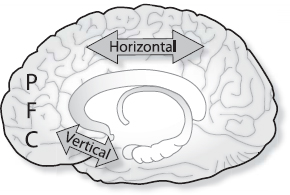
BOTTOM LINE: In parenting terms, you need a mature brain to parent well. It takes at least 20 years before your prefrontal cortex is developed enough to give you the powers of self-regulation that you need to parent well. Also, stress can impair your prefrontal cortex even after it has “matured.”
One of the most important brain structures for parenting is the anterior cingulate cortex (ACC for short). This is a structure that lies just beneath the neocortex, the outer layer of the brain, and runs in a narrow band along the midline of the brain from front to back. We focus on the front or anterior region of the cingulate, describing how this region serves as a “brain bridge” between the limbic system (the emotion-generating brain system) and the cognitive processes linked to the highest regions of the prefrontal cortex. By serving this bridging function, the anterior cingulate cortex helps parents connect their feelings to their thoughts in a flexible manner. This region is also an important part of the so-called executive attention system and of the self-monitoring system, making it a key structure in helping parents pay attention to their kids and to the feedback they receive from them.
Previously we described the role of the anterior cingulate in the transition from reptilian to mammalian parenting and its important contribution to parental empathy. In addition to its role in bringing feelings into awareness with the help of the insula and the amygdala, the anterior cingulate plays a vital part in helping to link the core processes of emotion regulation and self-reflection in the parenting brain. The anterior cingulate is the front part of the cingulate, a structure located in the middle of the brain just above the corpus callosum, that band of fibers that connects the left and right sides of the brain. Figure 1.9 shows the location of the anterior cingulate and the division of this region into three parts: the ventral, rostral, and dorsal. Also shown are the connections from the three anterior cingulate regions to the three key regions of the prefrontal cortex.
The reason the anterior cingulate is so important to parenting is that it connects both to the limbic system—the emotion-generating circuit—and to the three regions of the prefrontal cortex: the bottom region or orbital cortex; the middle region or middle prefrontal cortex, and the highest region, the dorsolateral prefrontal cortex (DLPFC). Because of its connections with all three regions of the prefrontal cortex, the anterior cingulate serves as a vital brain bridge that literally connects the emotion-regulating process at the bottom, in conjunction with the orbital region, to the reflective process of the middle prefrontal cortex, to the conflict resolution and planning processes of the dorsolateral prefrontal cortex at the top.
Figure 1.9. Connections between the ACC and OFC.
The ventral, rostral, and dorsal regions of the ACC connect to the OFC, MPFC, and DLPFC divisions of the prefrontal cortex and to the smart vagal system.
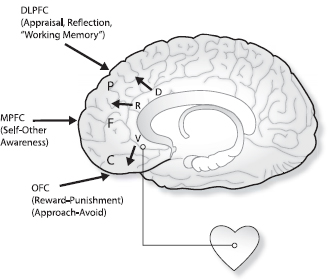
The bottom part of the anterior cingulate goes by several names in the brain science literature, including ventromedial, subgenual, and ventral anterior cingulate. (These terms all refer to the location of brain structures in relation to other structures). Whichever name we use, this region sits below the knee-like bend in the corpus callosum and is strongly connected to the amygdala and the autonomic nervous system, both the up-regulating sympathetic branch and the down-regulating parasympathetic branch. This makes the ventral anterior cingulate a crucial player in the parenting brain, despite its small size. In a healthy parenting brain, this region turns on whenever the amygdala reacts to something potentially threatening or negative, including a child’s behavior or negative facial expression (Heinz et al., 2005). By co-activating the ventral anterior cingulate along with the amygdala, the parent, without knowing it, is already beginning to regulate the negative reaction toward the child. In other words, if your brain doesn’t co-activate your ventral anterior cingulate with your amygdala, it will be harder for you to control your negative reaction. This includes both an angry and a fearful reaction. In brain-imaging studies of patients with anxiety disorders and depression, the ventral anterior cingulate fails to activate when the amygdala is triggered, a brain pattern associated with poor emotion regulation.
So, this little bottom region of the anterior cingulate cortex is quite an important part of the parenting process. In essence, activation of the ventral anterior cingulate begins the process of regulating a potentially unparental reaction. This braking operation allows you, as a parent, to start moving upward in your brain into the middle and topmost regions of your prefrontal cortex, if needed, to regain your parental state of mind, to reconnect with your smart vagal engagement system, and to think about what you are doing.
The activity of the anterior cingulate now shifts upward from the bottom to the middle region and to the top, called the dorsal anterior cingulate. The middle region provides access to your middle prefrontal region to promote self-reflection and attunement to your child’s feelings, while the dorsal anterior cingulate provides access to your highest prefrontal region, your dorsolateral prefrontal cortex, for reappraising your initial “take” on what’s going on, for gaining a “higher,” more objective understanding of the situation. Now, with the help of the anterior cingulate bridge, your brain is an open, flexible, reflective state that is conducive to a more mindful and sensitive way of relating to your child, regardless of the state of mind he or she is in. This is where you need to be in your brain when parenting gets challenging and the bottom-up system can’t do the job of keeping your brain in a parental state. This is when you need to use your top-down state regulation system, your executive powers, to be “the adult in the room.”
BOTTOM LINE: In parenting terms, the anterior cingulate bridge helps you to “feel and deal,” to stay connected to your feelings and your child’s feelings and to think at the same time—to be the “adult in the room.”
In order to respond sensitively and contingently to a child’s signals, parents have to utilize a brain system that evolved to monitor progress in staying on track with a goal or intention by detecting errors or deviations from the goal and making rapid corrections or adjustments in behavior to get back on track. In the domain of parent–child attunement, the parent has to use this self-monitoring, error-detecting, self-correction system in order to “stay attuned” to the child’s inner states.
The neural system that supports this self-monitoring and error-detection process is a circuit that relies heavily on the functioning of the anterior cingulate. The anterior cingulate becomes active when a person becomes conscious of a conflict or disparity between a current goal or purpose and the immediate feedback about progress toward that goal. The greater the conflict, the greater the activation in the anterior cingulate. People who exhibit strong anterior cingulate activation shortly after making perceived mistakes are more likely to make adjustments in their attentiveness and actions following error detection. In a sense, the anterior cingulate is part of the brain’s “uh-oh” system, alerting us that something is amiss and requires greater attention and more care.
This self-monitoring system is very important in parenting because it helps you to take in feedback from your child and use it to attune better to what is going on if what you are doing isn’t helpful or effective. Indeed, recent research shows a strong correlation between activation of the anterior cingulate after making a mistake on a computer-based task and sensitivity to a child’s feedback during parent–child interaction in the home (Fleming, Gonzalez, Afonso, & Lovic, 2008). This research suggests an important link between the ability to pay close attention to what you are doing—to be “mindful”—and the ability to attune to a child’s needs.
The internal conflict resolution system develops in stages in the brain, and its development has been shown to depend, in part, on the kinds of experiences one has early in life. Also, individuals vary greatly in the size and functioning of the neural circuitry that supports internal conflict resolution. Research using brain imaging comparing extraverted to introverted people shows differences in patterns of activation in the anterior cingulate regions associated with self-monitoring, error detection, and conflict processing. Extraversion correlates with lower activity in the anterior cingulate, whereas introversion correlates with greater activation in this brain region during tasks that require sustained attention to one’s own performance in relation to a specific goal.
Based on the growing research into the neural correlates of self-monitoring and internal conflict resolution, it seems likely that parents who exhibit poor attunement and low sensitivity to their children are “low activators” of the neural circuitry that supports self-monitoring, self-reflection, and reappraisal. This likelihood suggests that one of the goals of working with these parents would be to enhance the functioning of this self-monitoring system to facilitate greater reflectiveness and greater capacity to recover from disruptions in the parent-child relationship and to reconnect with the child.
BOTTOM LINE: In parenting terms, parental self-monitoring—your “uh-oh” system—alerts you that all is not well with your child or with the state of your relationship and prompts you to pay more attention to what is going on so you can respond more effectively, in a more attuned way.
Intriguingly, the top part of the anterior cingulate, the dorsal anterior cingulate, is now known to be a crucial part of what neuroscientists Michael Posner and Mary Rothbart (2007) call the executive attention system, the system we use when we have to keep our attention focused in the face of distractions and competing impulses and habits. This brain circuitry is known to develop and improve with age; we begin to show an adult-like level of attentional control around the age of 17, on average. The executive attention system makes it possible to stay focused or to shift attention in a flexible way, as needed, to stay on task or to adapt to changing situations. This system also is highly variable among individuals and tends to be more developed in females than males.
Parents are likely to vary widely in the structure and functioning of this brain system. Whereas parents with an underactive executive attention system will have difficulty attending sufficiently to their children, parents with overly active systems are prone to worrying too much about their children and to being hypervigilant about their safety. Research shows that this part of the brain is overly active in people who are chronic worriers, including people with obsessive–compulsive disorder (OCD) who are constantly getting signals from this region that make them feel that something is wrong and needs their immediate attention. So, it is probably best to be “in the middle” with regard to this aspect of parental executive functioning. In a later chapter on parental reflection (Chapter 6), we present recent research that suggests that parents can improve their executive attention system with certain kinds of mindfulness practice.
BOTTOM LINE: In parenting terms, parental executive attention allows you to shift your attention in a highly flexible way in response to your child’s changing needs and to changing circumstances.
Children are strongly motivated from birth to interact with adults, coming into the world equipped for social engagement. This means that the parent-child relationship is a reciprocal one from the start and that parents need to be responsive partners in this two-way dance.
Because infants are so dependent on our love, interest, and attention, they are born “wired” for engagement, ready from the get-go to capture our eyes and ears and hearts. Even newborns track our gaze and prefer that we look directly at them. Born knowing their mothers voice, they quickly start to associate that special sound with that special face. In turn, our brains are wired to be “captured” by our babies’ charms. Indeed, we are wired to experience our babies as adorable and irresistible even when others might not find them so precious, especially when they are throwing up, crying, and soiling their diapers. This is nature’s system of parent–child reciprocity, a mostly automatic, “bottom-up,” neurobiological dance that links us to our kids much more powerfully than our intellectual powers alone could ever do. As parents, we need to be moved by our child’s bids for attention; we need to be open and receptive as much as possible in order to reinforce the child’s efforts to engage us and to strengthen the child’s trust in us as communication partners. This engagement goes beyond the interactions based on distress and comfort that are associated with attachment security, expanding into the realm of sociability in which, as Colywn Trevarthen so beautifully describes, the parent becomes the child’s “first companion.” When the twin systems of attachment and companionship are well joined, parents and children create a robust two-way system that encompasses both comfort and joy as well as all the other human experiences that make our lives rich and deep.
Children are limbic creatures, making their way in their new world through expressing their feelings and trying out all the ways to move and emote. They need to have the space in which to give their limbic systems a full workout. This is how they learn to trust their own emotions and to feel safe inside their own bodies. Indeed, it is through the use of this system, of this “affective core,” that the child builds the brain power to regulate limbic drives. Too much restriction or a lack of sensitive parental co-regulation of the full range of a child’s affective experiences leads to underdevelopment of the brain system devoted to self-regulation. What is self-regulation? We’ll begin with what it is not: It is not suppression. Rather, it is the resilient capacity to “feel and deal,” to experience a full range of affect, and to modulate all kinds of feelings effectively enough to trust oneself to be able to cope well with the full range of human experience and to be an emotionally trustworthy partner and parent.
To help us understand this intriguing interplay between a child’s developing brain and the parenting brain, let’s meet Oscar. Oscar has just turned 1 year old at the time of this writing. He’s going to help us illustrate how kids learn to feel safe with “attachment figures” and how they engage parents in powerful, almost irresistible ways. Oscar is in the care of two loving parents, his biological mother and father, who are wild about him and highly attuned to his changing states of mind and body. In this photo we see him ready for connection with a magical gleam in his eye and even his lower lip, inviting us to come play. His wonderfully expressive face shows us in an instant, way too fast for conscious processing, that kids are wired for engagement. Infants seek out our faces and voices and poke us into smiling and tickling and playing as long as we can sustain the “game” by staying attuned to their feedback. If we are not too stressed out or distracted, we will respond in an instinctively positive way to a child’s endearingly smiling face and invitation to connect. Seeing Oscar’s smile causes specific “child-reading” regions of our brains to light up and send messages to our emotion-generating system, moving us to approach. This Parental Child Reading System is an interactive set of brain regions that enable the parent to perceive and respond to a child’s nonverbal communication in a sensitive, attuned way during the key stage for attachment formation and then throughout the parent–child relationship. Our Parental Child Reading System is activated by merely glancing at Oscar’s open, smiling face.

What’s happening in your brain as you look at Oscar? Although you can’t feel your brain working, you can get clues by paying close attention to what’s happening in your own face as you interact with Oscar’s. Do you feel a little crinkling of the muscles just below your eyes? Do your eyebrows go up a notch? Does you jaw drop a little as the left side of your face gets a little crooked, showing the strong activation of your approach system? You may be using your mirror neurons to emulate Oscar’s smile (see Photo 1.2).
The Social Engagement System ON.
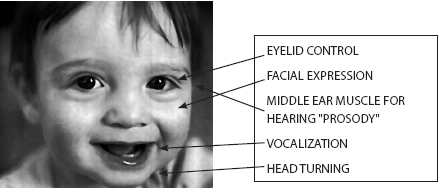
Oscar is actually using brain and body connections that are part of the social engagement system—the “smart” vagal circuitry described by Porges (2011). By turning his own social engagement system “on,” Oscar invites us to do likewise, to become mutually engaged with him. Notice how the two sides of his face are expressing his readiness to connect somewhat differently, one side more strongly than the other. This reflects the difference between the limbic systems on the right and left.
Even though you don’t know it, you probably just released some of that oxytocin into your limbic system, including into your amygdala. This release of oxytocin is part of the chemical dance that helps a parent to feel calm and loving when near the child. Oscar is also releasing oxytocin into his brain and body, helping him to feel safe and to stay in his engagement or approach system. Researchers have found that when parents and infants are engaged in a highly pleasurable, attuned interaction, both release oxytocin. In fact, intriguing research by Ruth Feldman and her colleagues shows that the parents with the highest levels of oxytocin during these moments of deep connection are the ones who report and demonstrate the strongest bonds with their babies (Feldman, Gordon, & Zagoory-Sharon, 2010).
Oxytocin is released through soothing kinds of physical contact, including hugs, caressing kinds of touch, and even massage. Oxytocin is also released when you hear the voice of a loved one, as when a college student hears his or her mother’s voice on a cell phone or when a child hears his or her mother saying, “It’s alright, everything will be alright” (Seltzer, Ziegler & Pollak, 2010). Because oxytocin can be released in multiple ways, even a depressed parent who has “flat affect”—does not express emotion in his or her face or voice—can stimulate the child’s oxytocin system through touch, including the use of infant massage. And if the mother (or father) receives massage therapy, this good touch may help to trigger her oxytocin system and get the antistress, antidepressant effects of soothing touch that she has been missing as she and her child have “lost touch” with each other (Field, 2002).
Since it is also known that stress hormones can suppress the production of oxytocin and the functioning of the oxytocin system, stressed-out parents may have difficulty turning the oxytocin system on and getting the great benefits in terms of well-being and “felt” safety that oxytocin confers. When there is chronic conflict in parent–child relationships, both parent and child may be deprived of all the benefits of “good touch,” leading to suppression of the oxytocin system in both. This oxytocin suppression is an important aspect of blocked care that makes it difficult to feel safe and warm and nurturing even when you want to experience these parental feelings. In a blocked relationship it is vital that the oxytocin system be revived to help restore good connections.
Because oxytocin has “stress-busting” effects, it is now thought to be a neuroprotective chemical that helps to keep the parent’s brain healthy and free from the potentially damaging effects of stress hormones. This is probably one of the reasons that good relationships have been found to promote better health and longevity in both men and women. Good adult relationships and good parent–child relationships can be thought of as protection for the brains of both partners, making positive relationships literally “good medicine” (Gordon, Zagoory-Sharon, Leckman, & Feldman, 2010).
If you were stressed out a bit before you saw Oscar, you may be calmer now. You may have even shifted your internal state of mind from a drowsy state to a more engaged, more interested state that helps you to understand this material about brains that could otherwise be too dry, too unemotional. This is the natural power of the child’s social engagement system: It helps to ensure that primary caregivers pay attention, experience pleasure, feel nurturing, and don’t develop blocked care.
Another way in which good relationships help promote brain development is by triggering the release of so-called brain growth factors. The brain produces a number of chemicals that promote growth, a key one being something called brain-derived neurotrophic factor,(neurotrophic means growth-inducing). In good relationships, both partners produce more brain-derived neurotrophic factor, and this increased production, in turn, promotes the continuing development of both partners’ brains (Roth, Lubin, Funk & Sweat, 2009). Brain-derived neurotrophic factor is active in regions of the brain that are crucial for good social and emotional functioning, especially the prefrontal cortex and the hippocampus (the structure that is so important for learning, memory, and stress regulation). Relationships that are safe and supportive appear to keep the brain-derived neurotrophic factor system activated, fostering growth in these key regions. In this way, good relationships help to build resilient brains.
In contrast, relationships that are chronically stressful and dysregulating to both parties are likely to suppress the activity of chemicals such as oxytocin and brain-derived neurotrophic factor in both. This growth-suppressing effect of poor interpersonal connections creates a scenario in which the relationship can become neurobiologically toxic, blocking brain growth and development and even producing the failure to thrive syndrome in children (Gerhardt, 2004; Perry 1997). These growth-suppressing relational dynamics ramp up the stress and defense systems—a brain pattern that can lead to a variety of stress-based disorders, including depression, anxiety, and PTSD. In essence, then, good relationships are neuroprotective and generative, mutually beneficial to both partners, while poor relationships are mutually dysregulating and growth-suppressing.
Below, we see Oscar again, but this time he’s looking at us with a bit of wariness, illustrating the freeze response. Now his lower vagal system is “on,” triggering immobilization with mild fear. Here, we see no crinkling of the muscles just below his eyes. This part of his face has gone flatter as he orients pretty intensely to our faces and tries to figure out whether it is safe or not to come close and engage us. His brow muscle is a little tense and his eyes are wide to take in as much as his brain can of what is going on. With his mouth open, he is actually also adjusting the muscle of his inner ear to hear the sounds we are making, to gauge our “prosody” to help him to know what state of mind we are in.
Photo 1.3. The freeze response.
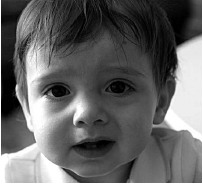
Again, notice the difference between the two sides of Oscar’s face. The right side (facing us), Oscar’s left, clearly shows a fearful expression, whereas the left side (facing us) looks more neutral, maybe mildly apprehensive. Oscar’s full face is displaying a combination of affect based on activity in the two sides of his brain. Since some aspects of facial expressions are orchestrated by the opposite side of the brain, the more fearful expression on Oscar’s left side probably reflects the activation of his fear system on the right side of the brain, his right limbic system. He has shifted from his smart vagal social engagement system into a defensive state in which his attention has been grabbed by something that has set off at least a mild alarm reaction from his amygdala. Although he is not in full flight mode, he is in a mild freeze mode, much like the “deer in the headlights” reaction we see in our fellow creatures when they suddenly get very still as they orient to something they’ve just heard or seen and focus on it intently to figure out whether or not there is a real danger.
Here we are seeing the effects of Oscar’s neuroception system as his amygdala does its job of trying to keep him safe by rapidly and unconsciously alerting him to stop playing and smiling and pay rapt attention to something in his environment that could be harmful. At this age, Oscar is not yet able to regulate his attention system by deciding to what he will or won’t pay attention. Rather, his attention gets drawn to things using what is called his orienting response. This is an obligatory attention system, controlled largely by his amygdala and its reaction to all the things he senses in his environment and inside his own body. Later, as his brain matures, he will develop a “higher,” more voluntary “executive attention system” that he can use to shift out of this obligatory, amygdala-driven way of attending to things. This higher attention system depends heavily on the development of the brain bridge we described earlier, wherein the anterior cingulate gets connected to the amygdala and gains control over the neuroceptive process, allowing the child to be less at the mercy of his amygdaloid moments.
It’s not hard to imagine, looking at Oscar’s face here, how a less fortunate child, living in a truly scary environment, could spend way too much time in a hypervigilant state about his safety and way too little time in carefree play, exploration, and joyful connection with primary caregivers. Having to use this freeze system a lot makes it stronger and easier to activate, setting the stage for chronic hypervigilance and difficulty relaxing around other people. Parents who grew up in unsafe environments tend to be hypervigilant about their safety and may have a hard time feeling safe enough to shift from defense into social engagement, even around their own children. You can see, then, how the development of a child’s smart vagal, social engagement system is highly dependent on the kind of care he or she receives during this early stage of brain development and how this early brain sculpting process lays some of the foundations for parenting later in life.
Fortunately, Oscar lives in safety. His amygdala is not reacting to his parents. Instead, he can turn to them for comfort and for help with emotion regulation, using them as a secure base when he needs to do so. Then, when he’s been comforted and has regained his equilibrium, he can engage his parents in joyful play or toddle off to explore that bug over in the corner, which he then eagerly tries to share with his startled parents. Seeing their looks of apprehension or disgust, he starts to shift from bug exploration to reconnecting with his parents and getting them to smile again so he will feel “in connection” with them. And so goes the dance of attunement, misattunement, and reattunement or relationship repair. This is the lovely parent–child dance that builds the child’s brain while helping him or her learn to trust safe people and to count on their sensitive care, giving the child the luxury of spending lots of time exploring and learning, a luxury unavailable to children of stressed-out parents.
And now, in Photo 1.4, we see Oscar in clear distress, not feeling good about whatever is going on in the moment. Maybe he is seeing us for the first time and reacting to our “strangeness.” He might next start looking for his mother. Here his brow is furrowed, his eyes are almost shutting, as if to avoid seeing something that is upsetting. He is ready to cry in distress to let someone special know that he needs comforting, that he needs to get back to his safe base. Don’t worry, Oscar, Mom and Dad are right there and soon, you’ll be smiling again (Photo 1.5).

The Virtuous Cycle: Helping the child recover from distress and regain safety
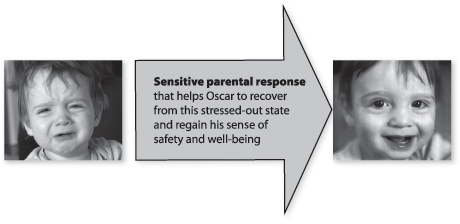
When Oscar’s parents respond in a timely, sensitive, attuned way to his distress, they are co-regulating his emotions and giving him the scaffolding he needs to transition out of distress back into a state of safety, well-being, and playful engagement. The daily repetitions of this good cycle in which parents help young children move from internal states of dysregulation back to more regulated states is known to promote brain development, both by protecting the brain from prolonged periods of distress and by stimulating the growth of connections in the child’s brain that eventually give him or her more powers of self-regulation. In this positive cycle, we see the foundations of the brain capacity to be a good parent (Atzil, Hendler & Feldman, 2011).
In Photo 1.6, we use Oscar’s different expressions to illustrate the process that Porges calls neuroception: the process by which our limbic system rapidly assesses for safety and threat and orchestrates our emotional and behavioral states accordingly.
Oscar demonstrating neuroception.
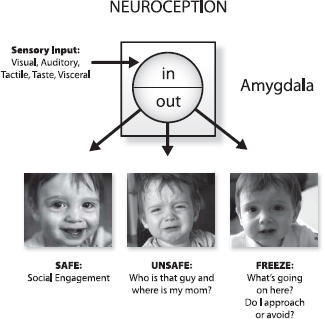
Thanks, Oscar, for helping us to understand the processes of social engagement, self-defense, neuroception, and secure attachment. And watch out for those bugs.
The challenge for your parenting brain is to stay in safe mode even when your child is not in his or her safe mode. If you can keep your smart vagal approach system “on” when your child shifts into a defensive state of mind, you are much more likely to respond in a caring, helpful way that fosters his or her emotional development and strengthens his or her ability to regulate defensive, negative states. Your ability to keep your lid on and stay “parental” helps your child build those brain “muscles” he or she will need to do the same with those wonderful grandchildren you will have someday. This is why the health of your brain is so vital to creating a really positive, growthful cycle of good care in your family. Figure 1.10 below summarizes the top-down, bottom-up state regulation processes in the parental brain.
Figure 1.10. Putting It All Together.
The top-down and bottom-up state-regulation system in the parenting brain.
